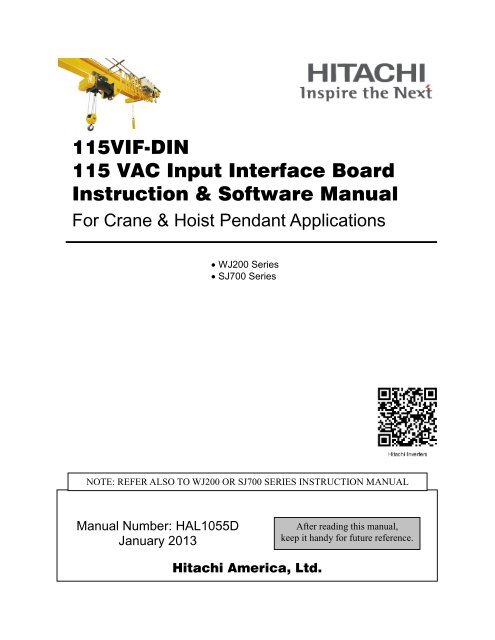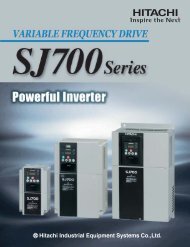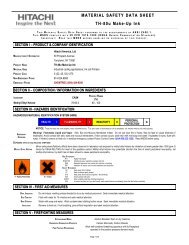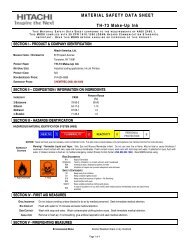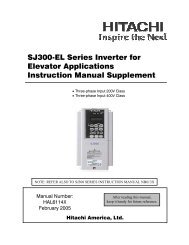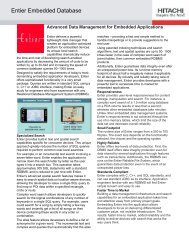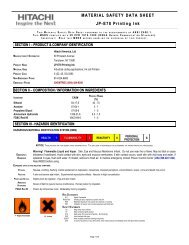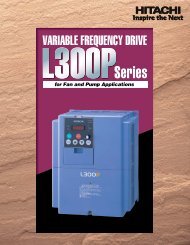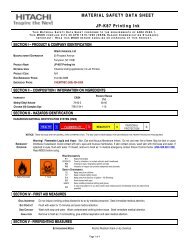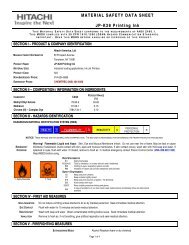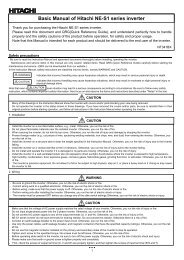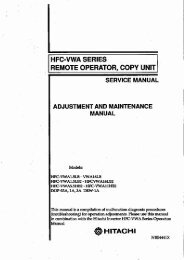115VIF-DIN 115 VAC Input Interface Board Instruction Manual ...
115VIF-DIN 115 VAC Input Interface Board Instruction Manual ...
115VIF-DIN 115 VAC Input Interface Board Instruction Manual ...
Create successful ePaper yourself
Turn your PDF publications into a flip-book with our unique Google optimized e-Paper software.
<strong><strong>115</strong>VIF</strong>-<strong>DIN</strong><br />
<strong>115</strong> <strong>VAC</strong> <strong>Input</strong> <strong>Interface</strong> <strong>Board</strong><br />
<strong>Instruction</strong> & Software <strong>Manual</strong><br />
For Crane & Hoist Pendant Applications<br />
• WJ200 Series<br />
• SJ700 Series<br />
NOTE: REFER ALSO TO WJ200 OR SJ700 SERIES INSTRUCTION MANUAL<br />
<strong>Manual</strong> Number: HAL1055D<br />
January 2013<br />
After reading this manual,<br />
keep it handy for future reference.<br />
Hitachi America, Ltd.
Chapter 1<br />
Table of Contents<br />
Table of Contents ................................................................................................................... 2<br />
Chapter 1 – General Description .......................................................................................... 3<br />
Chapter 2 – Installation and Wiring ...................................................................................... 5<br />
Chapter 3 – Configuring the Inverter ................................................................................... 9<br />
Chapter 4 – Operation .......................................................................................................... 11<br />
Index ..................................................................................................................................... 14<br />
Document History<br />
January 2013 is the first edition.<br />
Page 2 of 15
Chapter 1<br />
Chapter 1 – General Description<br />
The <strong><strong>115</strong>VIF</strong>-<strong>DIN</strong> is an interface board is used to translate <strong>115</strong> <strong>VAC</strong> control signals – from crane<br />
and hoist operator pendant stations – to the 24 VDC logical input signals required by the WJ200<br />
or SJ700 series of Hitachi inverters.<br />
The board provides optical isolation between the <strong>115</strong> <strong>VAC</strong> pendant voltages and the inverter<br />
control inputs. The necessary logic functions to perform application-specific crane and hoist<br />
functions are not embedded on the interface board.<br />
Before using this product, please read this manual and the inverter manual, and be sure to follow all safety<br />
precautions noted therein. After unpacking the <strong><strong>115</strong>VIF</strong>-<strong>DIN</strong> board, carefully inspect it for any defect or damage.<br />
<strong><strong>115</strong>VIF</strong>-<strong>DIN</strong> Carton Contents<br />
(1) <strong><strong>115</strong>VIF</strong>-<strong>DIN</strong> <strong>Interface</strong> <strong>Board</strong><br />
WARRANTY<br />
The warranty period under normal installation and handling conditions shall be eighteen (18) months<br />
from the date of purchase, or twelve (12) months from the date of installation, whichever occurs first.<br />
The warranty shall cover repair or replacement, at Hitachi’s sole discretion, of the <strong><strong>115</strong>VIF</strong>-<strong>DIN</strong><br />
interface board.<br />
Service in the following cases, even within the warranty period, shall be to the customers account:<br />
1. Malfunction or damage caused by misuse, modification or unauthorized repair.<br />
2. Malfunction or damage caused by mishandling, dropping, etc., after delivery.<br />
3. Malfunction or damage caused by fire, earthquake, flood, lightning, abnormal input voltage,<br />
contamination, or other natural disasters.<br />
If service is required for the product at your worksite, all expenses associated with field repair are the<br />
purchaser’s responsibility. This warranty only covers service at Hitachi designated service facilities.<br />
If making a warranty claims in reference to the above, please contact the distributor from whom you<br />
purchased the <strong><strong>115</strong>VIF</strong>-<strong>DIN</strong>, and provide the model number, purchase date, installation date, failure date<br />
and description of damage, malfunction, or missing components.<br />
Page 3 of 15
Chapter 1<br />
SAFETY PRECAUTIONS<br />
HIGH VOLTAGE: This symbol indicates high voltage. It calls your attention to items or operations<br />
that could be dangerous to you and other persons operating this equipment. Read the message and<br />
follow the instructions carefully.<br />
WARNING: Indicates a potentially hazardous situation that, if not avoided, can result in serious<br />
injury or death.<br />
CAUTION: Indicates a potentially hazardous situation that, if not avoided, can result in minor to<br />
moderate injury, or serious damage to the product. The situation described in the CAUTION may, if<br />
not avoided, lead to serious results. Important safety measures are described in CAUTION (as well as<br />
WARNING), so be sure to observe them.<br />
HIGH VOLTAGE: Motor control equipment and electronic controllers are connected to hazardous<br />
line voltages. When servicing drives and electronic controllers, there may be exposed components<br />
with housings or protrusions at or above line potential. Extreme care should be taken to protect<br />
against shock. Stand on an insulating pad and make it a habit to use only one hand when checking<br />
components. Always work with another person in case an emergency occurs. Disconnect power<br />
before checking controllers or performing maintenance. Be sure equipment is properly grounded.<br />
Wear safety glasses whenever working on electronic controllers or rotating machinery.<br />
WARNING: This equipment should be installed, adjusted, and serviced by qualified electrical<br />
maintenance personnel familiar with the construction and operation of the equipment and the hazards<br />
involved. Failure to observe this precaution could result in bodily injury.<br />
WARNING: HAZARD OF ELECTRICAL SHOCK. DISCONNECT INCOMING POWER<br />
BEFORE WORKING ON THIS CONTROL.<br />
WARNING: Wait at least ten (10) minutes after turning OFF the input power supply before<br />
performing maintenance or an inspection. Otherwise, there is the danger of electric shock.<br />
WARNING: Do not install or remove the <strong><strong>115</strong>VIF</strong>-<strong>DIN</strong> interface board while the inverter or external<br />
control circuits are energized. Otherwise there is the danger of electric shock and/or fire.<br />
WARNING: Never modify the board. Otherwise, there is a danger of electric shock and/or injury.<br />
CAUTION: Alarm connection may contain hazardous live voltage even when inverter is<br />
disconnected. When removing the front cover for maintenance or inspection, confirm that incoming<br />
power for alarm connection is completely disconnected.<br />
WARNING: Do not touch the surface or terminals of the <strong><strong>115</strong>VIF</strong>-<strong>DIN</strong> interface board while the<br />
inverter or external control circuit is energized; otherwise there is the danger of electric shock.<br />
Page 4 of 15
Chapter 2<br />
Chapter 2 – Installation and Wiring<br />
Orientation to Product Features<br />
Figure 2-1 below shows the <strong><strong>115</strong>VIF</strong>-<strong>DIN</strong> interface.<br />
Figure 2-1, <strong><strong>115</strong>VIF</strong>-<strong>DIN</strong><br />
Page 5 of 15
Chapter 2<br />
Installing the <strong>Interface</strong> <strong>Board</strong><br />
General<br />
WARNING: Remove power from the inverter and wait at least five minutes before moving to the next<br />
step. Open and remove the lower terminal cover. Confirm that the DC bus is fully discharged before<br />
proceeding further. Also confirm that the external <strong>115</strong> <strong>VAC</strong> control circuits are deactivated and locked<br />
out before proceeding. Otherwise, there is danger of electric shock, injury or death.<br />
The <strong><strong>115</strong>VIF</strong>-<strong>DIN</strong> interface board may be used with either the WJ200 or SJ700 series of inverters. Follow the<br />
appropriate installation instructions on the next pages for the particular model series in which you are installing<br />
the board. The board’s <strong>115</strong> <strong>VAC</strong>-side wiring (from the pendant) and the corresponding AC input functions are<br />
the same, regardless of which inverter series you are using.<br />
AC <strong>Input</strong> Wiring – Connecting the Pendant to the <strong><strong>115</strong>VIF</strong>-<strong>DIN</strong> <strong>Interface</strong> <strong>Board</strong><br />
Connect the pendant <strong>115</strong> <strong>VAC</strong> input wiring to the terminals marked AC1 through AC5 on the <strong><strong>115</strong>VIF</strong>-<strong>DIN</strong>, with<br />
NEU (neutral of the pendant control signals) as their common terminal. AC1 thru AC5 are connected to the<br />
HOT side of the pendant control signals, coming from the pendant’s pushbutton contacts. The board’s AC input<br />
terminal functions are as follows:<br />
INPUT HOIST TRAVERSE<br />
AC1<br />
(Note 1)<br />
AC2<br />
(Note 1)<br />
Up PB<br />
Down PB<br />
Forward/Left PB<br />
Reverse/Right PB<br />
AC3 Increase/2 nd speed Increase/2 nd speed<br />
Jumpered to HOT<br />
AC4<br />
(Note 2)<br />
AC5<br />
(Note 2)<br />
AC6<br />
AC7<br />
Common<br />
Up over-travel photo limit (NC sensor<br />
input; open-circuit stops/prevents UP<br />
motion – only DOWN motion is<br />
possible)<br />
Not used/no connection<br />
(NOTE: Neutral to be connected to AC<br />
Common)<br />
Horizontal over-travel limit (NC sensor input;<br />
open-circuit forces inverter to MIN speed)<br />
Jumpered to HOT<br />
Not used/no connection<br />
Note 1:<br />
Note 2:<br />
<strong>Input</strong>s AC1 and AC2 functions are symmetrical with respect to direction in traverse applications. In hoist applications, however, AC1 must be<br />
used for UP and AC2 must be used for DOWN.<br />
AC4 and AC5 inputs are intended to be used with over-travel limit sensors. These are secondary safeties, over and above N.C. limit switches<br />
that would be wired in series with the AC1 and AC2 pendant inputs. They are “fail-safe” inputs, for use with N.C. type sensors. In this way, a<br />
cut wire will have the same effect (inhibited of motion) as a sensor being triggered.<br />
Page 6 of 15
Chapter 2<br />
Connecting the <strong>Board</strong> to the Inverter<br />
The method of connection of the <strong><strong>115</strong>VIF</strong> to the inverter depends on the inverter model. Refer to the appropriate<br />
section below for the inverter model you have. If using for traverse application, AC1 and AC2 are symmetrical<br />
in purpose. Please jumper AC4 and AC5 for non-hoist applications.<br />
WJ200<br />
Figure 2-3, <strong><strong>115</strong>VIF</strong>-<strong>DIN</strong> wired to WJ200 Inverter inputs with pendant<br />
Page 7 of 15
Chapter 2<br />
SJ700<br />
When installed for use with an SJ700 inverter, the <strong><strong>115</strong>VIF</strong>-<strong>DIN</strong> must be mounted within the panel and in close<br />
proximity to the inverter. Please connect wiring leads (20 AWG) pigtail leads from the <strong><strong>115</strong>VIF</strong>-<strong>DIN</strong> to the I/O<br />
terminal strip of the SJ700 inverter. Connect the leads one by one to intelligent input terminals on the inverter<br />
following the same numeration coding as labeled and similarly shown on the <strong><strong>115</strong>VIF</strong>-<strong>DIN</strong> interface label, see<br />
Figure 2-3 on page 7. Also the FW must be used to activate the EzSQ program.<br />
Open-Loop vs. Closed-Loop SJ700<br />
For open-loop applications: the UP (blue) wire from the pigtail is connected to the FW terminal. In this case<br />
there is no connection to intelligent input 1, which is configured for no function [NO].<br />
For closed-loop (encoder feedback) applications: the UP (blue) wire from the pigtail is connected to<br />
intelligent input terminal 1, which is configured for [MI1] function. Refer to parameter tables in Chapter 3.<br />
Sinking/Sourcing <strong>Input</strong> Set-up<br />
On the SJ700, the factory default setting for the intelligent inputs is for sinking logic. The <strong><strong>115</strong>VIF</strong>-<strong>DIN</strong> interface<br />
requires the inputs be set for sourcing logic for proper operation. To change the logic setting, locate the small<br />
metal jumper bar on the intelligent input terminal strip. Then:<br />
1) Remove the jumper from its default position (shown below) between the P24 terminal and PLC<br />
terminal.<br />
2) Reinstall the jumper between the PLC terminal and the CM1 terminal<br />
(1) M3 x 8 mm<br />
screw<br />
Page 8 of 15
Chapter 3 – Configuring the Inverter<br />
Program Flowchart and Index<br />
The configuration of inverter parameters will depend on the specific functionality and performance required for<br />
your application. The basic functionality of the board is designed to interface with a two pushbutton,<br />
two-position (two-speed) momentary contact type pendant commonly used for crane and hoist applications. This<br />
is the basis for the descriptions of the functions of the board presented in this manual. The setup in the table<br />
below will result in infinitely variable speeds between the programmed MIN and MAX speeds. The defined<br />
functions of the pushbuttons are as follows:<br />
UP<br />
UP, first detent: UP – accelerate to minimum speed<br />
UP, second detent: UP – increase speed while held, up to MAX speed (or go to second speed, see page 11)<br />
DOWN<br />
DOWN, first detent: DOWN – accelerate to minimum speed (RESET fault when inverter is<br />
STOPPED and in a fault state)<br />
DOWN, second detent: DOWN – increase speed, up to MAX speed (or go to second speed, see page 11)<br />
Pushing either the UP or DOWN pushbutton to the first position causes the inverter to go to the minimum<br />
configured speed in that direction. Pushing that button further to its second position will cause speed to increase<br />
in that direction. Releasing back to first position will hold that last speed. Releasing the pushbutton all the way<br />
will cause the inverter to come to a stop. If that button is re-pressed to the first position before stop is reached,<br />
that speed will be maintained. In order to achieve this basic functionality, the installation of the EzSQ C&H<br />
program must be downloaded to the inverter through the use of Hitachi ProDriveNext software. The software is<br />
available to download from our company website.<br />
This program also will require a change in parameters that differ from factory default values, as described in the<br />
following table. The application will also write to these parameters as needed.<br />
Parameter<br />
Code<br />
Function Setting Comment<br />
F002 Acceleration Time Note 1<br />
Set a value between 1 and 3600 seconds, depending on application. If P031<br />
is set to 03, acceleration is controlled by EzSQ. This is field adjustable.<br />
F003<br />
Deceleration<br />
Set a value between 1 and 3600 seconds, depending on application. If P031<br />
Note 1<br />
Time<br />
is set to 03, deceleration will be controlled by EzSQ. This is field adjustable.<br />
A001<br />
Frequency<br />
Command<br />
07 Tells the inverter to read speed reference from EzSQ program. See note 3.<br />
A002 Run Command 01 Tells the inverter to take the RUN command from the control terminals.<br />
A004<br />
Maximum<br />
Depending on the motor limits and application requirements, set the<br />
Note 1<br />
Frequency<br />
appropriate value, (Must be equal or greater than P120 parameter)<br />
P120<br />
Upper Frequency<br />
Limit<br />
Note 1 Usually the same value as A004. See note 3. This is field adjustable.<br />
P110<br />
B091<br />
C001<br />
Lower Frequency<br />
Limit<br />
Stop Mode<br />
Selection<br />
Terminal 1<br />
Function<br />
Note 1<br />
Lowest speed for continuous operation (MIN speed), usually 6 to 10 Hz or<br />
so. This is the speed that will be commanded at the first pushbutton position.<br />
See note 3. This is field adjustable.<br />
00 For Non-Load Brake Hoist, or for traverse applications: 00 (factory default)<br />
01 For Load Brake Hoist applications: 01 (free-run or coast to stop)<br />
56 WJ200 = [MI1]. See note 3.<br />
no SJ700 Open Loop = [NO] No function<br />
56 SJ700 Closed Loop = [MI1]. See note 3.<br />
Page 9 of 15
C002<br />
C003<br />
C004<br />
C005<br />
C006<br />
C007<br />
C008<br />
C011 thru<br />
C016[DN]<br />
C102<br />
Terminal 2<br />
Function<br />
Terminal 3<br />
Function<br />
Terminal 4<br />
Function<br />
Terminal 5<br />
Function<br />
Terminal 6<br />
Function<br />
Terminal 7<br />
Function<br />
Terminal 8<br />
Function<br />
Terminal Active<br />
State<br />
Reset function<br />
selection<br />
01 SJ700 Open Loop = [RV] Reverse run<br />
Program Flowchart and Index<br />
57 WJ200 & SJ700 Closed Loop = [MI2]. See note 3.<br />
58 EzSQ input 2 nd speed / increase speed. = [MI3]. See note 3.<br />
59 EzSQ input. Horizontal over-travel limit. = [MI4]. See note 3.<br />
60 EzSQ input. N.C. from hoist UP limit. =[MI5]. See note 3.<br />
18 [RS] Reset on WJ200.<br />
62<br />
no<br />
00<br />
2<br />
EzSQ input. This input switches the software from 2 speeds to infinite speed<br />
control. =[MI7]. See note 3.<br />
[NO] No Function – Available on SJ700 only<br />
All inputs should be configured for N.O. (normally open = active on)<br />
operation (Note 2)<br />
Makes the RESET [RS] input terminal (input 6) active only when the inverter<br />
is in the fault state. In this way, the pendant DOWN pushbutton can also<br />
used to reset an inverter fault. See note 3.<br />
P031<br />
Accel / Decel<br />
Option<br />
03<br />
This allows the EzSQ software to determine the programmed acceleration<br />
and deceleration rates. If F002 and F003 are used, set to 00.<br />
Note 1: Actual setting is dependent on inverter capacity and your design requirements. Software controlled when applicable.<br />
Note 2: C011 to C018 in the case of SJ700 series<br />
Note 3: The parameters initial values are set by activating the EzSQ program.<br />
Other Required Settings<br />
The following were previously noted in the Installation and Wiring chapter, but are important and bear<br />
repeating. Make sure the following steps were performed.<br />
WJ200<br />
Please confirm that the jumper bar/wire is between PLC and L, as explained in Chapter 2, for proper operation<br />
of the <strong><strong>115</strong>VIF</strong>-<strong>DIN</strong> interface board.<br />
SJ700<br />
The SR/SK DIP switch in close proximity to the terminal connection block must be in default “SR” position.<br />
Confirm that the source/sink jumper bar is between PLC and CM1, as explained in Chapter 2. Confirm the<br />
correct setting of B091 for load-brake vs. non-load-brake applications. Please verify the SJ700 parameter A017<br />
is set to 01 and a jumper or closed contact is wired between P24 and FW to enable to program to run.<br />
Software Use Set Up<br />
The EzSQ program needs to be successfully downloaded to the inverter and activated through the A017<br />
selection to 02. The software is designed to utilize the intelligent logic inputs to determine the rotation direction,<br />
and speed of the motor based on the various contact states as presented to the inverter through the <strong><strong>115</strong>VIF</strong>-<strong>DIN</strong>.<br />
Please remember to test the software with a disconnected load, and perform all activities and take all proper<br />
precautions before activating the software or inverter. Safety in operation should be the primary concern.<br />
Please visit our website at http://www.hitachi-america.us/ice/inverters/ for the ProDriveNext software and<br />
suggestive use crane and hoist program in our application notes section.<br />
Page 10 of 15
Program Flowchart and Index<br />
Two-Speed Operation<br />
The inverter can easily be configured for two-speed operation or infinitely variable speed operation by using the<br />
following parameter settings in lieu of or in addition to those in the table above:<br />
Parameter<br />
Code<br />
A017<br />
C017<br />
Function Setting Comment<br />
EzSQ<br />
Operation<br />
Terminal 7<br />
Status<br />
00, 01,<br />
02<br />
00, 01<br />
00 deactivates the C&H EZSQ software. 01 will activate the software<br />
when the terminal FW is active on SJ700 units. 02 will make EZSQ<br />
active at all times on WJ200 only.<br />
00 is used for 2 speed operation. 01 is for infinite variable speed<br />
control<br />
The 2 speed control selection for the inverter is based on parameter C017, (C017=00) is applicable to<br />
pendant stations with two-position pushbuttons, and can be applied to hoist and/or traverse axes. With<br />
the above settings, at the first pushbutton position, the inverter will ramp to MIN speed as defined in<br />
parameter P110 and hold. On depressing the button to the second pushbutton position, the inverter will<br />
accelerate to the P120 parameter set speed and hold. Releasing the pushbutton back to the first position<br />
will cause the inverter to decelerate back to the MIN speed as set in P110 and hold. Releasing the<br />
pushbutton will cause the inverter to come to a stop.<br />
Infinite Variable Speed Operation<br />
Normal Operation<br />
Once the inverter parameters are set as described in Chapter 3, you are ready to verify proper operation. It is<br />
recommended to first test the system with the motor mechanically disconnected from the crane or hoist, to<br />
ensure that any unexpected behavior will not damage the equipment or risk injury.<br />
Energize the inverter and the pendant or other external control circuit power supplies, and press the pushbutton<br />
connected to input terminal AC1. This is the UP hoist or FORWARD/LEFT traverse input. Observe motor<br />
rotation. If direction is NOT correct, remove power from the inverter and wait 10 minutes for the capacitors to<br />
discharge. Then interchange any two motor leads. Restore power and repeat the initial test. Direction should<br />
now be correct. Once the corresponding AC1 pushbutton pressed to the first detent, the motor will accelerate in<br />
the forward direction, (corresponding to UP motion for the hoist), to the frequency set in P110 (MIN speed), and<br />
remain at that speed, unless:<br />
• The pushbutton is released, in which case the motor will come to a stop, OR<br />
• Ramp to a higher speed, while pushbutton is pushed to the second detent (AC3). If AC1 or AC 2 is<br />
maintained, and AC3 is subsequently released, the speed attained at that time will be maintained.<br />
• Releasing AC1 or AC 2 at this point will cause the motor speed to ramp down or stop.<br />
• If AC1 or AC 2 remains off long enough, the motor will come to a stop.<br />
• If AC1 is re-activated at any speed above the MIN speed, then that speed will be maintained for the<br />
duration. If AC1 is reactivated at a speed below the MIN speed, the motor will accelerate to MIN speed<br />
and maintain that speed until one of the above events occurs.<br />
The function of AC2 pushbutton is the same as the AC1 pushbutton, with the exception that rotation direction is<br />
reversed (corresponding to DOWN operation for a hoist).<br />
Page 11 of 15
Program Flowchart and Index<br />
Troubleshooting<br />
Symptom<br />
Remedy<br />
Inverter will not accelerate beyond minimum speed <strong>Input</strong> AC4 is not jumpered to HOT<br />
Inverter will only turn the motor in one direction <strong>Input</strong> AC5 is not jumpered to HOT<br />
Note: For other troubleshooting tips, refer to Chapter 6 of the pertinent inverter <strong>Instruction</strong> <strong>Manual</strong><br />
Electrical Specifications<br />
The board does require power for the AC inputs, however, the outputs are powered from the inverter’s internal<br />
24 Vdc power supply, drawing approximately 21 mA. The AC inputs are optically isolated, and draw<br />
approximately 2 mA each. The outputs to the inverter have a 100 mA maximum capacity.<br />
EzSQ Program Flowchart Diagram<br />
Page 12 of 15
Program Flowchart and Index<br />
Functionality Table (based on contact status)<br />
Up (AC1)<br />
Up / Hi Speed<br />
(AC1 &AC3)<br />
Down (AC2)<br />
Down / Hi Speed<br />
(AC2 & AC3)<br />
Side Limit (AC4) Up Limit (AC5) Motor Output<br />
Open Open Open Open Closed Closed No motor output<br />
Closed Open Open Open Closed Closed Up at Min. speed or last speed<br />
Closed Closed Open Open Closed Closed Up, accelerates to Max speed<br />
Open Open Closed Open Closed Closed Down at Min. or last speed<br />
Open Open Closed Closed Closed Closed Down, accelerates to Max. speed<br />
Closed Open Open Open Open Closed Up, only at Min. speed<br />
Closed Closed Open Open Open Closed Up, only at Min. speed<br />
Open Open Closed Open Open Closed Down, only at Min. speed<br />
Open Open Closed Closed Open Closed Down, only at Min. speed<br />
Closed Open Open Open Closed Open No motor output<br />
Closed Closed Open Open Closed Open No motor output<br />
Open Open Closed Open Closed Open Down at Min. or last speed<br />
Open Open Closed Closed Closed Open Down, accelerates to Max. speed<br />
Closed Open Closed Open Closed Closed No motor output<br />
Closed Closed Closed Closed Closed Closed No motor output<br />
Closed Closed Closed Open Closed Closed No motor output<br />
Closed Open Closed Closed Closed Closed No motor output<br />
Closed Closed Closed Closed Open Closed No motor output<br />
Closed Closed Closed Open Closed Open No motor output<br />
Page 13 of 15
Index<br />
Program Flowchart and Index<br />
A<br />
AC <strong>Input</strong> Wiring · 7<br />
C<br />
Closed-loop · 8<br />
Configuration, inverter · 9<br />
Contents, carton · 3<br />
D<br />
DIP switch · 10<br />
E<br />
Electrical Specifications · 12<br />
F<br />
Faults, resetting · 10<br />
Functionality table · 9<br />
H<br />
Hoist · 6, 11<br />
I<br />
<strong>Input</strong> functions · 11<br />
Installing · 6<br />
Inverter parameters · 9<br />
J<br />
Jumper bar · 8<br />
L<br />
Layout, physical dimensions · 5<br />
Load-brake ·10<br />
M<br />
MIN speed · 11<br />
O<br />
Open-loop · 8<br />
Operation · 11<br />
P<br />
Pendant · 7, 9<br />
R<br />
Reset, fault · 10<br />
Rotation, direction of · 11<br />
S<br />
Safety Precautions · 4, 6, 10<br />
Sensor, (N.C limits)over-travel · 7<br />
Sinking/sourcing · 8<br />
WJ200 · 7, 10<br />
SJ700 · 8<br />
Software State Diagram · 12<br />
Speed, minimum · 11<br />
SR/SK · 10<br />
T<br />
Traverse · 6<br />
Trip reset · 11<br />
Troubleshooting · 12<br />
Two-speed operation · 11<br />
W<br />
Warranty · 3<br />
Wiring · 6<br />
Page 14 of 15
Hitachi America, Ltd.<br />
Tarrytown, NY 10591<br />
© 2009<br />
http://www.hitachi-america.us/inverters<br />
January, 2013<br />
HAL1055D


